If you or a loved one is living with diabetes, you know how important it is to manage blood sugar levels. Juicing can be a powerful tool in your diabetes management plan, providing a delicious and convenient way to incorporate essential nutrients into your diet. In this article, we will explore the benefits of juicing for diabetics, discuss the best fruits and vegetables to include in your juices, and provide some helpful tips for getting started on your juicing journey.
Juicing Recipes for Diabetics
The best type of juicers for making diabetic-friendly juices are masticating juicers, also known as cold-press or slow juicers. These juicers work by slowly crushing and then pressing fruits and vegetables to extract the juice, which helps in preserving the nutrients and enzymes. Masticating juicers are particularly beneficial for diabetics because they are more efficient at extracting juice from leafy greens and low-sugar vegetables, which are an essential part of a diabetes-friendly diet.
Moreover, the slow juicing process reduces heat and oxidation, resulting in a higher-quality juice with less foam and better flavor, making it easier to include a variety of nutritious, low-sugar vegetables in a diabetic diet. Remember, whether you’re using these recipes or creating your own, it’s crucial to monitor your blood sugar levels and consult with a healthcare professional or nutritionist before making any significant dietary changes.
1. Green Juice Recipe For Diabetics
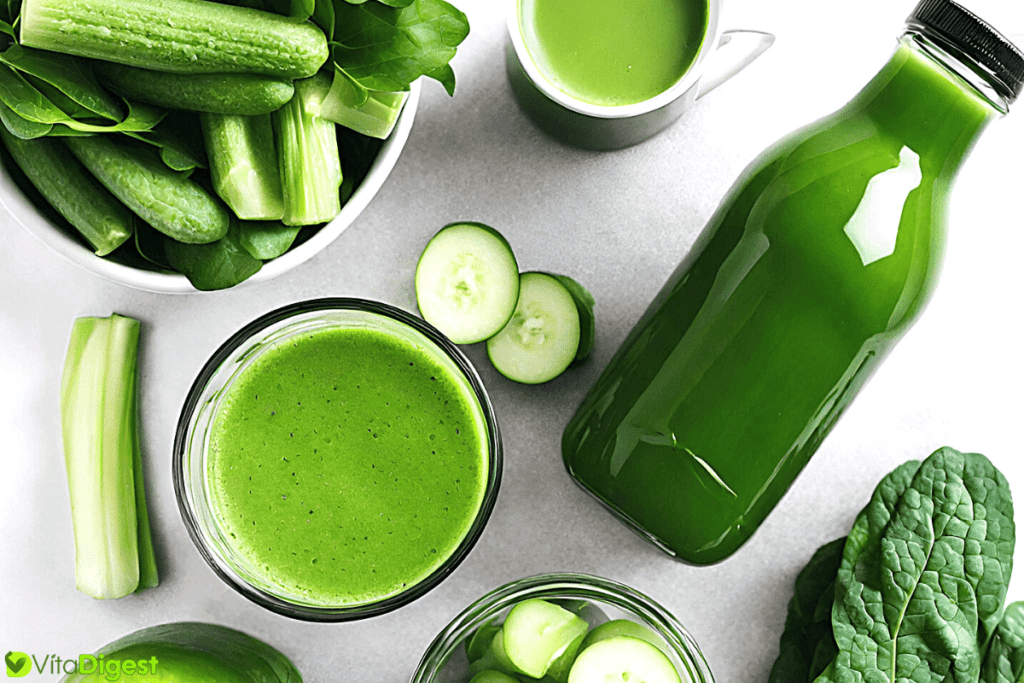
Green juice is a great option for diabetics as it is packed with essential nutrients and low in sugar. Here’s a simple yet delicious green juice recipe:
Ingredients:
- 2 cups of fresh spinach
- 1 cucumber
- 2 celery stalks
- 1 green apple (optional for added sweetness)
- Instructions:
Instructions:
- Wash all the ingredients thoroughly.
- Cut the cucumber and celery into small pieces.
- Core and slice the green apple.
- Put all the ingredients through your juicer.
- Stir the juice well and serve immediately.
Green juice is rich in vitamins, minerals, and antioxidants, which can help regulate blood sugar levels and improve insulin sensitivity. Additionally, the fiber content in this juice can aid in slowing down the absorption of sugar into the bloodstream.
2. Beetroot and Carrot Juice Recipe For Diabetics
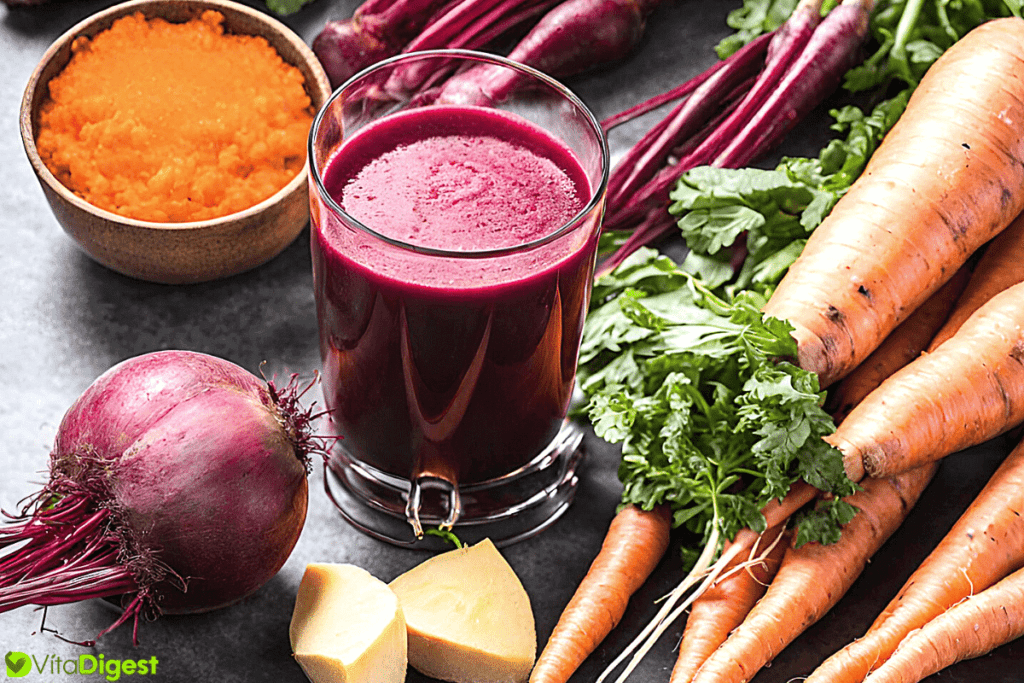
Beetroot and carrot juice is another excellent choice for diabetics. It provides a good amount of fiber, vitamins, and minerals. Here’s a simple recipe to try:
Ingredients:
- Ingredients:
- 1 medium-sized beetroot
- 2 carrots
- 1-inch piece of ginger (optional for added flavor)
Instructions:
- Wash and peel the beetroot, carrots, and ginger.
- Cut them into small pieces for easy juicing.
- Pass all the ingredients through a juicer.
- Mix well and serve immediately.
Beetroot and carrot juice are known to have blood sugar-lowering properties. It can also improve cardiovascular health and provide a boost to the immune system.
3. Cabbage Juice Recipe For Diabetics
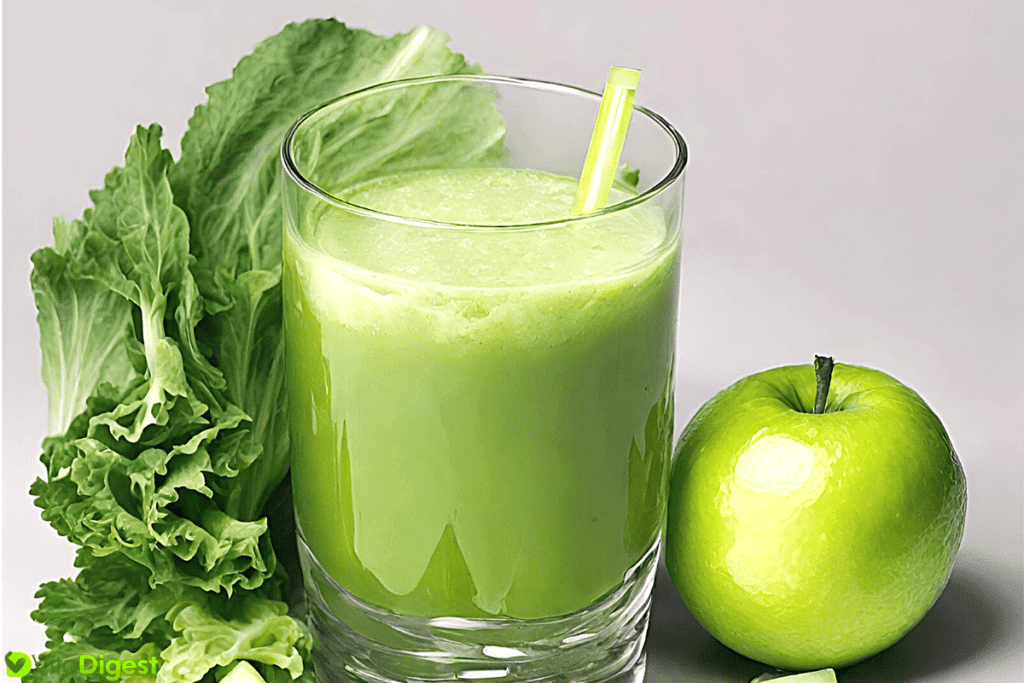
Cabbage juice may not be the most appealing option, but it’s highly beneficial for diabetics. Cabbage is an excellent source of vitamin C, vitamin K, and fiber. Here’s a simple recipe to prepare cabbage juice:
Ingredients:
- 1/4 medium-sized cabbage
- 1 green apple (optional for added sweetness)
- 3 Celery Stalks
- 1 Lemon
Instructions:
- Wash the cabbage thoroughly and cut it into small pieces.
- Core and slice the green apple.
- Cut the celery stalks and lemon into small pieces
- Pass both the cabbage and apple through a juicer.
- Mix well and serve immediately.
Cabbage juice may help lower blood glucose levels and improve digestion. It’s also known to have anti-inflammatory properties that can benefit those with diabetes.
4. Cucumber Juice Recipe For Diabetics
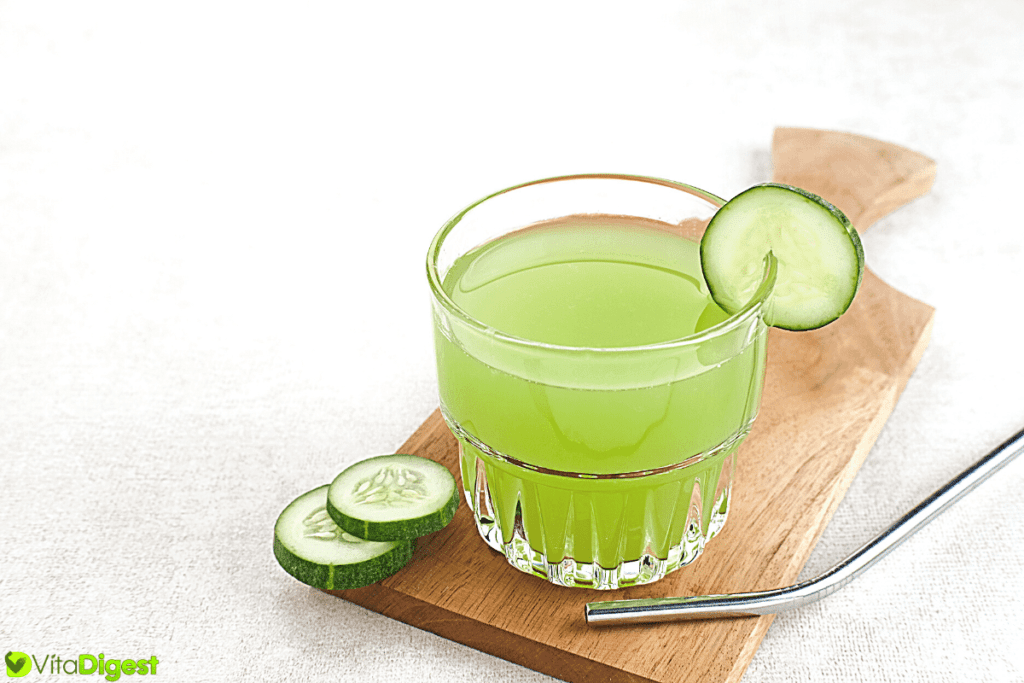
Cucumber juice is hydrating, refreshing, and a great choice for diabetics. Cucumbers are low in sugar and calories but high in water content and vital nutrients. Here’s a simple cucumber juice recipe:
Ingredients:
- 2 cucumbers
- 3 stalks of Celery
- 2 cups of Kale
- 1 Lemon
- 1 Green Apple
Instructions:
- Wash the above ingredients thoroughly.
- Cut them into smaller pieces for easier juicing.
- Pass the cucumbers through a juicer first, followed by the kale, celery, lemon, and green apple for sweetness.
- Stir well and serve immediately.
Cucumber juice can help regulate blood sugar levels, promote hydration, and support overall health and detoxification.
Is Juicing Good For Diabetics?
Juicing can be a contentious topic for diabetics because it often involves consuming the concentrated sugars from fruits and vegetables without the fiber that helps regulate blood sugar levels. For individuals with diabetes, consuming whole fruits and vegetables is generally recommended over juicing, as fiber plays a crucial role in slowing down the absorption of sugar, thereby helping to control blood glucose levels.
However, juicing can still be part of a diabetic diet if done carefully, focusing on vegetables over fruits to minimize sugar intake and possibly blending with some of the pulp to retain fiber. Diabetics need to monitor their blood sugar response to juicing and consult with a healthcare professional to ensure it fits within their dietary needs.
Controlling Blood Sugar Levels
When it comes to managing diabetes, one of the most important goals is to keep blood sugar levels under control. Juicing can be a beneficial tool in achieving this goal. By juicing fruits and vegetables, we can create delicious and nutritious concoctions that have a minimal impact on blood sugar levels.
Most juices are naturally low in carbohydrates, especially when compared to processed juices and sugary beverages. This means that they have a smaller effect on blood sugar levels. Additionally, the fiber found in fruits and vegetables slows down the absorption of sugars into the bloodstream, further helping to regulate blood sugar levels. This makes juicing a great option for diabetics who need to monitor their sugar intake.
Increasing Nutrient Intake
A key aspect of managing diabetes is ensuring that we are getting all the necessary nutrients to support our overall health. Juicing provides a convenient way to increase our nutrient intake. By juicing a variety of fruits and vegetables, we can easily consume a high concentration of essential vitamins, minerals, and antioxidants.
Diabetics often struggle with nutrient deficiencies due to the limitations imposed by their condition. Juicing allows us to extract the maximum amount of nutrients from fruits and vegetables, making it easier for our bodies to absorb and utilize them. This can help to improve overall well-being and reduce the risk of diabetes-related complications.
Promoting Weight Loss
Obesity and weight gain can exacerbate the symptoms of diabetes and increase the risk of complications. Juicing can be a helpful tool in promoting weight loss and maintaining a healthy weight.
Most fruits and vegetables used in juicing are low in calories and high in nutrients. This means that we can enjoy a satisfying and filling glass of juice while still keeping our calorie intake in check. Additionally, the high fiber content of fruits and vegetables can help to curb hunger and prevent overeating. By incorporating juicing into our diabetes management plan, we can support weight loss efforts and improve our overall health.
Choosing the Right Ingredients
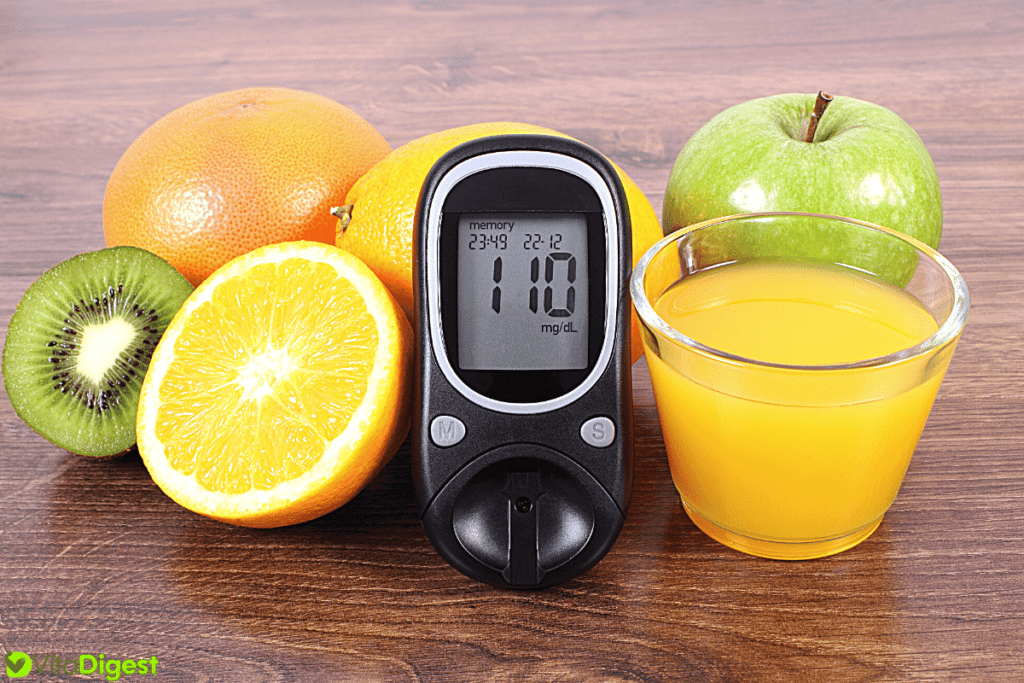
When it comes to juicing for diabetics, selecting the right ingredients is essential. By choosing low-glycemic fruits, non-starchy vegetables, and incorporating healthy fats and proteins, we can create nutritious and blood sugar-friendly juices that support optimal health for individuals managing diabetes. Let’s delve into each category to help you make informed choices.
Low-glycemic fruits
Opting for fruits with a low glycemic index is crucial for maintaining stable blood sugar levels. The glycemic index (GI) measures how quickly carbohydrates in food are converted into sugar and released into the bloodstream. Fruits with a lower GI are digested more slowly, preventing spikes in blood sugar after consumption. Here are some great low-glycemic fruits to consider for your juices:
- Berries: Blueberries, raspberries, and strawberries, are packed with antioxidants and fiber, making them wonderful choices for their low glycemic impact.
- Apples: Apples contain soluble fiber, which helps regulate blood sugar levels and promotes a feeling of fullness.
- Citrus fruits: Oranges, grapefruits, and lemons are not only low in sugar but also high in vitamin C, providing numerous health benefits.
Non-starchy vegetables
Including a variety of non-starchy vegetables in your juices adds essential nutrients, fiber, and minerals without significantly impacting blood sugar levels. These vegetables are low in carbohydrates and high in vitamins and minerals, making them an excellent choice for juicing. Here are some examples to include:
- Leafy greens: Spinach, kale, and Swiss chard are rich sources of vitamins A, C, and K, as well as magnesium and calcium.
- Cucumbers: With their high water content and refreshing taste, cucumbers provide hydration and contribute to overall juicing quality.
- Celery: High in fiber and low in calories, celery not only adds flavor but also aids digestion and supports heart health.
Healthy fats and proteins
Incorporating healthy fats and proteins into your juices can help balance blood sugar levels and promote satiety. These ingredients slow down the absorption of sugars into the bloodstream and provide a sustained source of energy. Consider adding the following to your juicing:
- Avocado: Rich in healthy monounsaturated fats, avocados add creaminess and offer a host of heart-healthy benefits.
- Chia seeds: Packed with fiber, omega-3 fatty acids, and protein, chia seeds contribute to a well-rounded and filling juicing experience.
- Almond butter: A tablespoon of almond butter not only adds a delightful nutty flavor but also provides protein, healthy fats, and vitamin E.
By carefully selecting low-glycemic fruits, non-starchy vegetables, and incorporating healthy fats and proteins, we can create delicious and nutritionally balanced juices for those managing diabetes. Remember to consult with a healthcare professional or nutritionist before making any significant dietary changes. Let’s explore more about the benefits of juicing for diabetics in the subsequent sections.
Fruits That Diabetics Should Avoid
Diabetics should generally avoid fruits that are high in sugar and have a high glycemic index, as these can cause spikes in blood sugar levels. Here are seven fruits that are often recommended to be consumed in moderation or avoided by diabetics:
- Pineapples – High in sugar and can cause blood sugar spikes.
- Mangoes – Rich in sugar and carbohydrates.
- Bananas (especially overripe ones) – High in sugar and carbs.
- Grapes – High sugar content can lead to increased blood glucose levels.
- Cherries (without moderation) – Though they have a lower glycemic index, their sugar content can add up quickly.
- Dried fruits (like raisins, dates, and figs) – The dehydration process concentrates their sugar content, making them very high in glucose.
- Watermelons – They have a high glycemic index, which can lead to rapid increases in blood sugar.
It’s essential for diabetics to monitor their fruit intake and choose fruits with a lower glycemic index and lower sugar content, such as berries, apples, and pears, while also considering their overall portion sizes and the impact on their blood sugar levels.
Tips for Juicing Safely
Monitor portion sizes
When it comes to juicing for diabetics, portion control is key. While fruits and vegetables are generally healthy choices, it’s important to remember that they still contain natural sugars that can affect blood sugar levels. It’s recommended to stick to about 4-6 ounces of juice per serving, and no more than 16 ounces per day. This will help maintain a balanced intake of carbohydrates and prevent spikes in blood glucose levels.
Combine fruits and vegetables
Adding a variety of both fruits and vegetables to your juicing recipes can provide a wider range of nutrients while helping to balance the sugar content. Vegetables like leafy greens (such as spinach and kale), cucumbers, and celery are great choices for their low sugar content and high nutritional value. Fruits like berries, citrus fruits (such as lemons and grapefruits), and apples can add natural sweetness to your juices while providing essential vitamins and minerals.
Avoid adding extra sugar
It’s important to avoid adding extra sugar to your juicing recipes, especially for individuals with diabetes. This includes avoiding sweeteners like honey, agave syrup, or maple syrup. Instead, focus on using whole fruits and vegetables that already contain natural sugars. If you find that your juice needs a little bit of sweetness, consider adding a small amount of low-glycemic index fruits like berries or a squeeze of lemon or lime juice for a refreshing flavor boost.
Precautions for Juicing with Diabetes
It’s important to consult with a healthcare provider before making any significant dietary changes, including incorporating juicing into your routine. They can provide personalized advice based on your specific health needs and help determine if juicing is suitable for you.
While juicing can be a healthy addition to a diabetic diet, it’s essential to monitor your blood sugar levels closely. The natural sugars present in fruits and vegetables can still impact your blood glucose levels. By regularly checking your levels, you can better understand how juicing affects your body and make adjustments as needed.
Juicing should not be used as a complete meal replacement for individuals with diabetes. It is essential to maintain balanced and varied nutrition to meet your body’s needs. Juicing can be a great way to supplement your diet with additional nutrients, but it shouldn’t replace whole foods and a well-rounded meal plan.
Frequently Asked Questions
What juicing is good for diabetes?
Juicing that is good for diabetes typically focuses on low-sugar vegetables, such as leafy greens and non-starchy vegetables, to minimize blood sugar spikes. Adding a small amount of fruit can improve flavor while keeping sugar content in check.
Are celery and carrot juice good for diabetics?
Celery and carrot juice can be good for diabetics when consumed in moderation, as celery is low in sugar and carrots provide essential nutrients without significantly raising blood sugar levels if portion sizes are controlled.
Is carrot and apple juice good for diabetics?
Carrot and apple juice should be consumed cautiously by diabetics because apples can add a significant amount of sugar to the juice, potentially impacting blood sugar control, so it’s important to keep portions small and monitor blood sugar levels.


1 thought on “Safely Juicing for Diabetics”
Comments are closed.